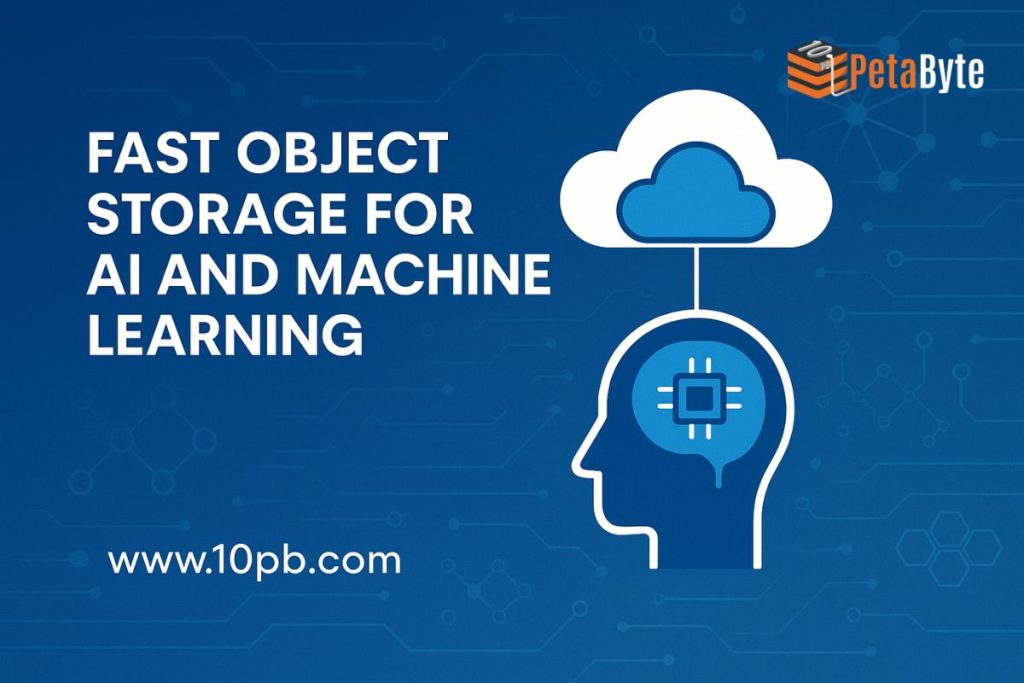Introduction
The success of Artificial Intelligence (AI) and Machine Learning (ML) depend on using giant datasets. Utilizing the datasets to train neural networks and analyze unstructured data – including video, images, and logs – relies heavily on how fast users and applications can store and retrieve the data. File and block storage models will likely struggle because they do not scale, or perform consistently, enough to support AI and ML workloads.
This is where real innovation occurs with 10pb object storage, which is built for speed, elasticity, and reliability. It offers the systematic foundation that supports AI and ML workloads. With parallel processing, high throughput, and inherent compliance capabilities, companies can innovate without worrying about data performance blockers.
Why Object Storage Matters for AI/ML
- Built for Scalability
When it comes to AI / ML workloads, capacity always needs to grow. Object storage has a flat architecture that allows you to remove folder structures, letting organizations use the cloud to store billions of objects, while keeping performance high.
- Ingest Data Fast
Training datasets can be massive, sometimes spanning into multiple petabytes. Object storage supports fast data ingestion for researchers and engineers to quickly push data into systems and prepare your data pipelines for model training.
- Parallel Access and High Throughput
One of the main benefits of object storage is its ability to read in parallel. When you want to access data in multiple GPUs, or nodes simultaneously, it will provide very high throughput without queuing for IO. This speeds up training and reduces the overall processing time.
- Security and Compliance Built-In
Many AI applications are going to provide regulated data like health records, financial data, or intellectual property. Object storage solutions give you the ability to encrypt data, provide role-based access, and ensure compliance to regulated standards like HIPAA, GDPR, and India’s DPDP Act.
Looking for Premium Services in Netforchoice
- Cost-effective
Unlike traditional storage that is rate-based, object storage uses tiered usage models. The most frequently accessed datasets can remain living in the high-performance storage tier, while stale or archived files live in lower cost tiers and can save you money overall.
Know About : Cloud Data Storage Pricing in India
Core Benefits of Object Storage in AI/ML
Infinite Scalability – Easily accommodates billions of files without limit on structure.
API Compatible – Fully compliant with S3 APIs for easy integration into AI/ML workflows.
Highly Durable – Protecting the data in the event of loss through replication and erasure coding.
Globally Accessible – Bring teams all over the world to the same repository for seamless collaboration.
Versioning & Immutability – Protect datasets from the risk of ransomware while retaining full history.
Practical Use Cases
Autonomous Driving
Connected vehicles and autonomous vehicles are generating terabytes of data every single day.It serves as a central, scalable place where machine learning teams can access, test, and retrain models in accordance with brand and regulatory compliance.
Healthcare & Research
Hospitals manage sensitive and complex datasets—MRI images, genomic sequences, clinical records. Object storage secures and allows for instant retrieval with regulatory compliance.
Are you Looking for : Own Micro Data Center for Hospitals?
Finance & Banking
Fraud detection and risk analysis are based on algorithms that analyze billions of transactions in real time. Object storage supports large datasets with the performance and resiliency levels required for financial artificial intelligence.
Media and Entertainment
Film studios and streaming companies are processing large video files and high-resolution assets. Object storage can streamline this process by allowing for parallel access to datasets that create faster editing, rendering, and content delivery.
How Object Storage Supports AI Pipelines
The AI lifecycle—data ingestion → cleaning → training → deployment → monitoring—depends on storage performance.
- Ingestion: Manages large uploads with minimal latency
- Pre-processing: The speed of reading documents in parallel accelerates preparation.
- Training: A distributed training environment benefits from virtually unlimited seamless scalable access.
- Deployment: Models and results can be saved and routed version-wise for retrieval.
- Monitoring: Logs and feedback loop data continuously flow into object storage for other iterations of preparation and usage.
The Road Ahead
Due to the rising adoption of AI, organizations encounter an exponential increase in data volume. Object storage is evolving to meet the challenge; we have smarter tiering, AI-enhanced optimization, and edge-ready deployment models. It is not only enabling AI but defining what digital transformation means.
FAQs
- What are the advantages of object storage compared to file systems for AI/ML uses?
It can scale infinitely, and provide greater parallel access, while file systems typically run out of steam with their performance and limits of the hierarchy i.e. tree format (files) structure
- Does object storage work with TensorFlow or Pytorch?
Yes. The majority of modern object storage solution are S3 compatible, you should have no trouble integrating your AI frameworks.
- Is object storage secure for sensitive AI workloads?
For sensitive content, It can encrypt data, and support access policy through compliance with standards such as HIPAA, GDPR.
- Is object storage affordable for small start-up companies?
Definitely. Pricing can vary between providers, but cloud object storage share flexibility of pricing based on used capacity, any company (small or large) only pays for what they use or need.
- What industries leverage object storage for AI workloads the most?
Healthcare, finance, self-driving car and media, not surprising because of the large volumes of complex data.

